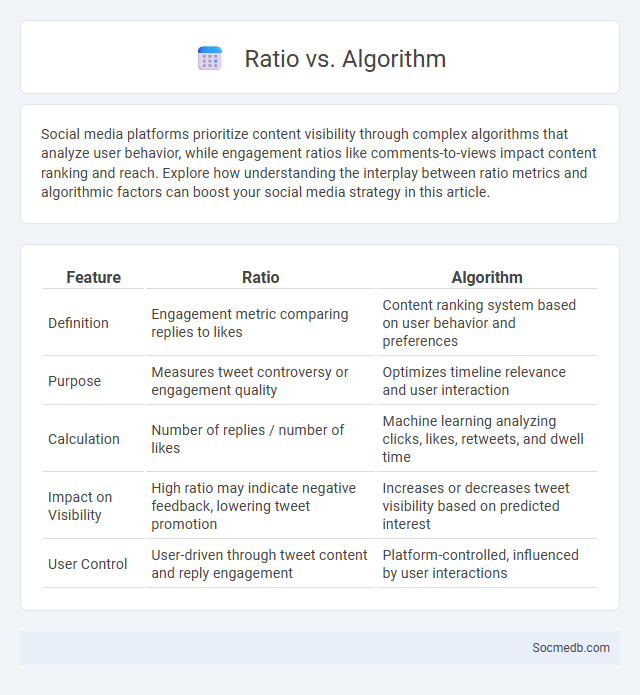
Photo illustration: Ratio vs Algorithm
Social media platforms prioritize content visibility through complex algorithms that analyze user behavior, while engagement ratios like comments-to-views impact content ranking and reach. Explore how understanding the interplay between ratio metrics and algorithmic factors can boost your social media strategy in this article.
Table of Comparison
| Feature | Ratio | Algorithm |
|---|---|---|
| Definition | Engagement metric comparing replies to likes | Content ranking system based on user behavior and preferences |
| Purpose | Measures tweet controversy or engagement quality | Optimizes timeline relevance and user interaction |
| Calculation | Number of replies / number of likes | Machine learning analyzing clicks, likes, retweets, and dwell time |
| Impact on Visibility | High ratio may indicate negative feedback, lowering tweet promotion | Increases or decreases tweet visibility based on predicted interest |
| User Control | User-driven through tweet content and reply engagement | Platform-controlled, influenced by user interactions |
Understanding the Concept of Ratio
Understanding the concept of ratio on social media involves analyzing the relationship between likes, comments, and shares to gauge content engagement effectively. Your ability to interpret these ratios helps optimize posts for better audience interaction and platform algorithms. Tracking this data empowers you to refine strategies and boost overall social media performance.
What Is an Algorithm?
An algorithm in social media is a set of complex mathematical formulas and data-driven processes designed to filter, prioritize, and deliver content tailored to individual user preferences. Platforms like Facebook, Instagram, and TikTok use machine learning algorithms to analyze user behavior, engagement patterns, and content relevance, optimizing the feed to maximize user interaction and time spent on the platform. Understanding how these algorithms work is essential for marketers aiming to enhance content visibility and for users seeking a personalized online experience.
Ratio Defined: Types and Applications
Ratio in social media refers to the engagement metric comparing the number of replies to likes or retweets, often indicating the public sentiment toward a post. Common types include reply ratio, like-to-reply ratio, and retweet-to-reply ratio, each helping analyze audience interaction and content reception. Applications of ratio analysis enhance brand monitoring, crisis management, and user behavior insights, optimizing marketing strategies on platforms like Twitter and Instagram.
Algorithms Explained: Structure and Function
Social media algorithms analyze user behavior, preferences, and interactions to personalize content feeds, ensuring maximum engagement and relevance. These complex structures use machine learning to continuously adapt, prioritizing posts based on factors like recency, popularity, and your past activity. Understanding how these algorithms function empowers you to optimize your content visibility and reach targeted audiences more effectively.
Comparing Ratio and Algorithm: Key Differences
Comparing ratio measures the engagement level of social media content by calculating the proportion of interactions such as likes, comments, and shares relative to the number of followers or views. Algorithms determine the visibility and ranking of content on social media platforms by analyzing user behavior, content relevance, and interaction patterns to personalize feeds. Understanding the key differences between comparing ratio and algorithm is essential for optimizing social media strategies and increasing audience reach.
Use Cases: When to Use a Ratio vs. an Algorithm
Social media platforms utilize ratios for straightforward metrics like engagement rates and follower growth to quickly assess content performance. Algorithms analyze complex data patterns including user behavior, preferences, and interaction history to curate personalized feeds and optimize content delivery. Employ ratios for transparent benchmarking and algorithms for dynamic, user-specific content optimization.
Mathematical Foundations: Ratio vs. Algorithm
Social media platforms rely heavily on mathematical foundations, particularly the use of ratios and algorithms, to prioritize content and enhance user engagement. Ratios such as click-through rates (CTR) and engagement ratios measure user interaction and influence content visibility, while complex algorithms analyze vast datasets to personalize feeds and predict user behavior. Understanding the distinction between these metrics and algorithmic processes is crucial for optimizing social media strategies and improving overall platform performance.
Real-World Examples: Ratio vs. Algorithm
Real-world examples illustrate how social media platforms like Instagram and Twitter use algorithms to prioritize content based on engagement metrics such as likes, comments, and shares, often favoring posts with a high engagement ratio. Your visibility depends not only on content quality but also on how the algorithm interprets user interaction rates, leading to viral trends or overlooked posts. Understanding the balance between the engagement ratio and algorithmic preferences is crucial for maximizing your social media reach and influence.
Advantages and Limitations: Ratio vs. Algorithm
Social media platforms utilize both ratio-based and algorithm-based content curation methods to optimize user experience and engagement. Ratio-based models prioritize posts with higher engagement metrics like likes, comments, and shares, which can amplify popular content but may overlook niche or emerging topics. Algorithm-based systems analyze user behavior and preferences to deliver personalized feeds, enhancing relevance but potentially creating echo chambers and limiting exposure to diverse viewpoints.
Choosing the Right Approach: Ratio or Algorithm?
Choosing the right approach for social media content delivery involves balancing ratio-based methods and algorithm-driven systems to maximize engagement. Ratio-based approaches prioritize consistent timing and frequency of posts, ensuring steady visibility, while algorithmic methods tailor content distribution based on user behavior and preferences, enhancing personalized reach. Understanding platform-specific algorithms and analyzing performance metrics is essential for optimizing content strategy and achieving targeted audience growth.
 socmedb.com
socmedb.com